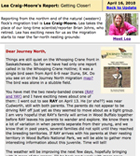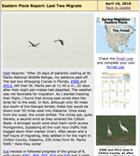The last two dawdlers finally left Florida’s St. Marks NWR on April 14 and four Texas whoopers have crossed into Canada. Meet Lea from our Canada Field Team. Calculate the number of days the Class of 2009 chicks spent on the wintering grounds. Nesting news from Wisconsin and a new slideshow make us think. What do you see in this photo that might have made the cranes fly away?
Today's Report Includes:
- Migration News: Map and Field Reports
- Journal: Calculations, Comparisons
- Eastern Flock: Nesting Update
- Slideshow: Spring Return: What's Next?
- Links: Helpful Resources to Explore
Image of the Week

Photo:
Sue Kersey
 Western Flock News |
 Data /Map |
 Eastern Flock News and Finish Line |
|
The 2010 spring migration is early and swift! Four birds, including newly banded juvenile RAY, have crossed into Canada and we are delighted to introduce you to Lea Craig-Moore, who will oversee the flock on their Canadian nesting grounds and send us the news. |
|
The last two juveniles (#906 and #912) finally left St. Marks NWR at midday April 14, and eight of the nine Chass chicks that departed April 5 were back at Necedah NWR on April 11! At least 79 cranes have completed migration. Which cranes have now crossed the finish line? More |
The youngest cranes are home — or on their way. Until this season, April 9 was the latest date that the young cranes led south by Operation Migration project launched their return migration. It makes us wonder:
- Now that they've all departed, how many days did the ultralight-led Class of 2009 spend on the wintering grounds? The chart you filled out for the Class of 2009 last fall can help, or see our chart for the arrival dates and the departure dates you need for your calculations.
- With
the help of this
page, check your answer and then compare the average
number of days on the winter
grounds
to the other
ultralight-led classes.What might explain the differences? How
does the class of 2009's time compare to the others ?
ICF's Sara flew over the nest of pair #212 & 419 in Wood County, Wisconsin on April 5 and this is what she saw (click on the photo for a close-up view):
 |
Then what? "On April 14 the nest of #212 and #419 failed. That means in the past week all nine nests (see chart) in the eastern flock have failed and there are no active nests now," came the sad news from Sara. What kind of nesting results did this crane pair have last summer? See bio page to find out.
Why is this happening? Experts are working to find an answer so nests can succeed. Whooping crane nesting studies at Necedah National Wildlife Refuge this spring included video cameras to "watch" some of the Whooping crane nests and aerial surveillance support from Operation Migration. (The pilot flew high enough to keep from disturbing the birds.) Zero biting insects were seen at three of the first four failed nests, while four adult black flies were seen flying around another failed nest. More information is needed before experts can determine why the crane pairs, who do everything else right, do not stay with their nests.
But it's not all bad news. Some pairs may nest again. Thanks to faster discovery of failed nests, the eggs have been rescued. Many should hatch in the care of experts so the new chicks can be part of Whooping crane recovery efforts. And — we have more 100 Whooping cranes migrating in the eastern flyway where none were migrating a decade ago!
The crane chicks born in 2009 turn one year old this April, May or June. How have they changed in a year? What have they learned to do?
All the concern, work and care to help the chicks has now paid off. This is their first spring and summer as wild, free Whooping cranes. What will they do all summer? What will they eat? What will they need to be careful about? How are they preparing for their future?
Our slideshow has some answers, with beautiful photos from the scientists and trackers who have watched over them. Enjoy the story!
- Teachers/Overview: About This Study
- Image of the Week: What made this crane pair fly away?
- Scientist Field Team: Meet Lea Craig-Moore
- Field Report: Western Flock
- Field Report: Eastern Flock
- Journal Question Support: Comparing Migrations
- Journal Question Support: Number of Days on the Wintering Grounds
- Data: Nesting Summary, Eastern Flock
- Slideshow: Spring Return: What's Next?
- Making Good Sightings: Official WCEP Reporting form
- Record Keeping: Arrival Log for Eastern Flock
- Journal: Downloadble Journey North Journal Pages
The Next Whooping Crane Migration Update Will Be Posted on April 23, 2010.



